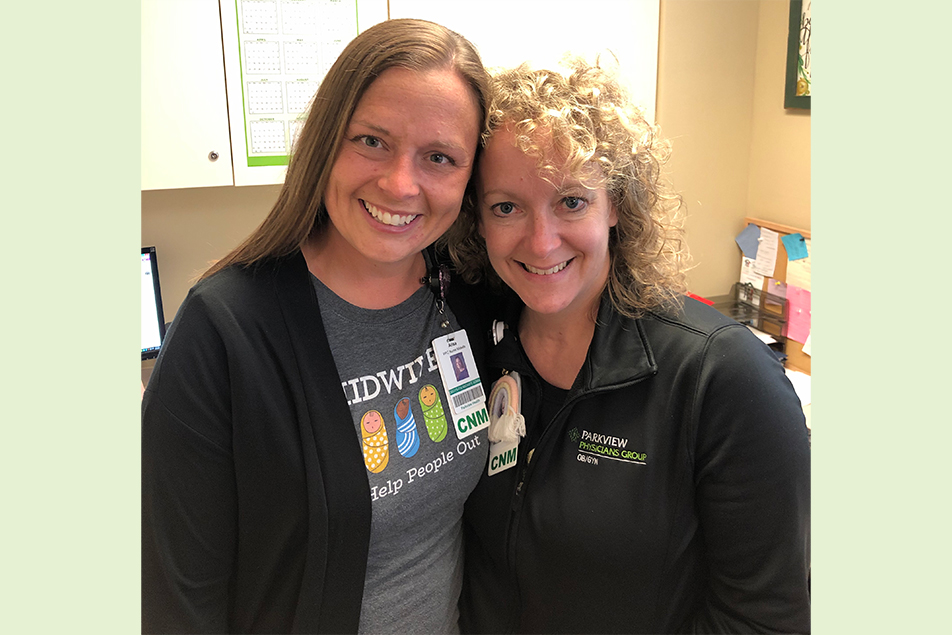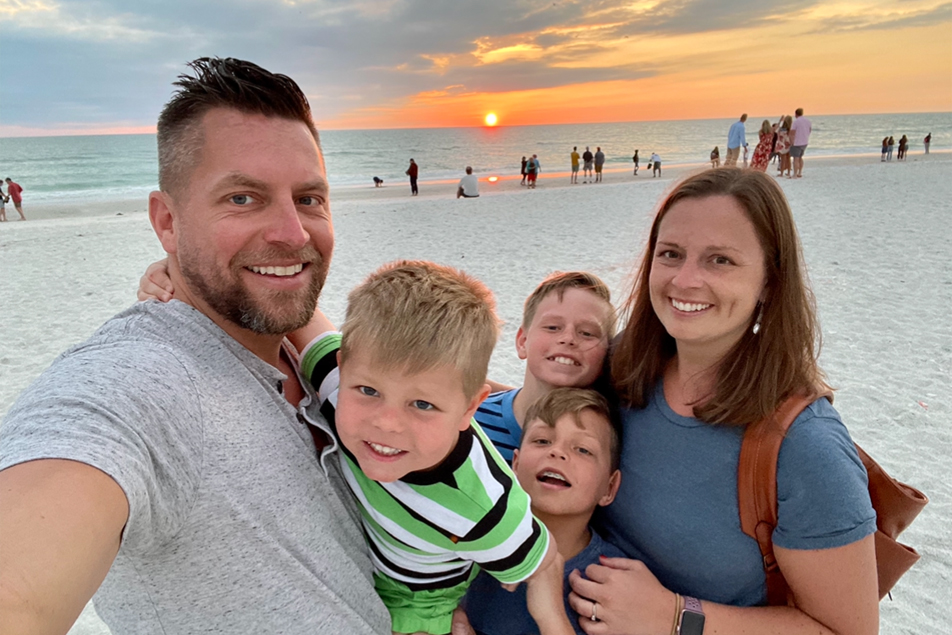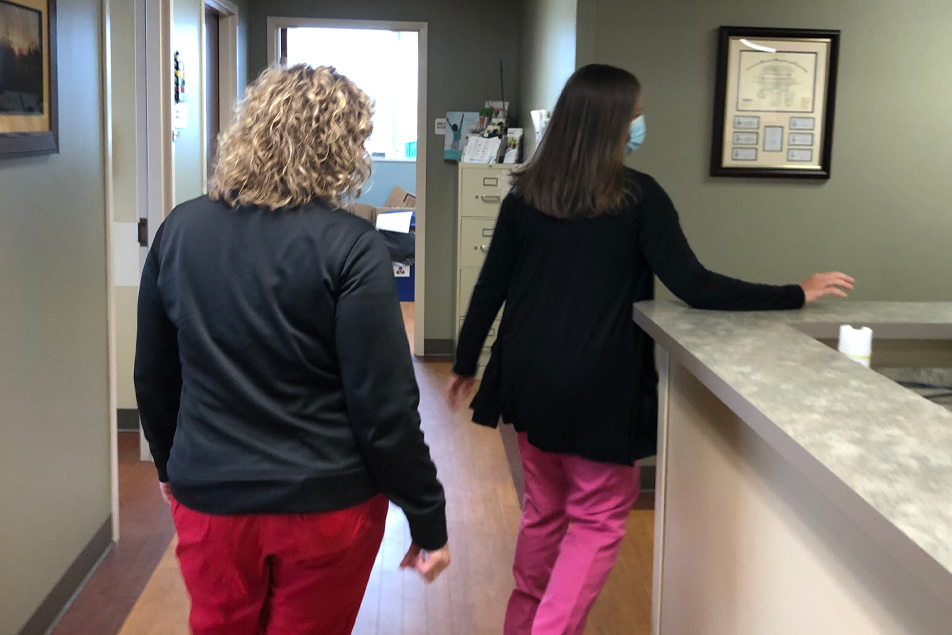
This post was written by Emma Hetrick, digital copywriter, Parkview Health.
Do you remember those Choose Your Own Adventure books? I used to love them when I was younger. The interaction and immersive nature of each story had me turning page after page to see what would happen next and where my choices would take me. As I reflect on my time shadowing certified-nurse midwives Alisa Felke, CNM, PPG – OBGYN, and Shelly Boone, CNM, FNP-C, PPG – OB/GYN, I can’t help but notice the similarities. Every door they walk through is like a new chapter where they face a variety of characters, challenging and beautiful situations, and learn to embrace everything life throws their way.
A little background
I arrived at Parkview Huntington Hospital around 8:30 a.m. I parked on the backside of the building, carefully choosing my spot next to a maple tree with sprawling branches and deep green leaves in the hope that it would shade my front seats from the rising temperatures and warm rays of the summer sun.
I clipped on my badge and proceeded to entrance three, taking the elevator up to level two. The silver doors opened, and I made my way down the quiet hallway to suite 215, my curiosity peaking for what the day might hold as I turned the handle to the OB/GYN office.
I met Alisa and Shelly in their shared space. The cozy office is adorned with pictures of their loved ones lining the windowsill and heartfelt thank you notes from grateful patients crowding the walls. I settled in as Alisa and Shelly worked diligently to catch up on emails, update charts and check schedules, getting ready for the day. When I sensed they were ready, I launched into my questions, starting with the most obvious but necessary, “What do midwives really do?”
Alisa explained that midwives are often known for the care they provide women during pregnancy, labor and birth (they lovingly refer to themselves as “baby catchers”), but many don’t realize that these compassionate professionals do so much more than that. They go through years of schooling and hundreds of hours of training to be able to provide comprehensive care for women throughout their lifespan. From puberty to menopause, they perform physical exams, prescribe medication, order lab work and imaging, and conduct medical procedures while focusing on their overarching goal of education.
“The word midwife means ‘with women,’ which I think is so beautiful because that’s the type of relationship we aim to have with our patients,” Alisa said. “You see, we strive to create a partnership with each woman we see so they can be involved in their care and part of the decision-making process. We do everything we can to meet each person where they are currently in their lives, health and pregnancies.”

Becoming a midwife
With time to spare before patients arrived, I had to know more about the paths these providers took to arrive in their current roles. I turned to Alisa first. “Tell me, how did you become a midwife?”
Alisa smirked. "That's a great question." She paused to take a small sip of her iced coffee. "My first degree was actually in biology," she said. "Initially, I wanted to be a missionary doctor, but soon realized I didn't want to commit to medical school. Nursing was more appealing and suited my personality and talents better, so I switched."
I coaxed her further, asking, "Was it that simple?" Laughing, she said, "Oh, of course not! During my junior year of college, I was at the birth of my niece, which was an incredible experience and one of the most amazing things I've ever seen. It changed me forever. But that was only one side of the coin. Another instance that helped solidify my decision happened when I was in nursing school. I not only worked as a nurse's aide on a postpartum floor, but my maternal child professor was a midwife. I remember thinking, 'You're a nurse practitioner, but you deliver babies?' It blew my mind! That's when I realized that's what I wanted to do. So, I worked in med surg for a few years, gained some experience, transferred to labor and delivery when an opening popped up, and went to midwifery school. The rest is history."
I posed the same question to Shelly. She squared her shoulders and took a breath. "My path is a bit different," she mused. "I was a family nurse practitioner for 12 years with an obstetrical background, and never in my life had I thought about switching to midwifery. It just wasn't on my radar," she explained. "But I had a friend I worked out with every morning at the YMCA back then. She was very holistic and pregnant with her third child. Days past her due date, she called me as I was getting ready for work, informing me that she was in labor. I was elated and so pumped because she invited me to come and watch the process unfold. Within 30 minutes of my arrival, she gave birth to a happy, healthy baby girl. It was such a profound experience and turning point in my life."

Sitting in on patient visits
Patients began to fill the small waiting room, Alisa's first appointment among them. The nursing staff called her patient back and escorted her into an exam room. After asking the patient for permission, Alisa invited me in.
Alisa eased into normal conversation with the newly pregnant mother, asking how she was feeling and how her morning was going, calming any nerves that may have been lingering in the space between them. Their friendly banter morphed easily into discussing how things would unfold as her pregnancy progressed, including routine lab work, genetic testing, proper nutrition and exercise. Since she was only in the first trimester, the mom-to-be had many questions and concerns. Alisa continued to nod, smile, and reassure her that it was all normal, "Remember, your body and uterus are going through a lot of changes right now, expanding to make room for your growing baby." Alisa asked the patient if she would like to listen to her baby's heartbeat. Her eyes instantly lit up as she emphatically nodded at the opportunity and early pregnancy milestone.
In the hallway after the first appointment, Shelly invited me to accompany her to a prenatal checkup with a patient due in a couple of weeks. Turning on my heels, I made a prompt U-turn and followed her. Shelly warmly introduced me to the patient and her husband. I thanked them profusely for allowing me to observe their visit. I watched as Shelly and her patient naturally sank into a familiar routine, discussing her current condition and the baby's movements with particular emphasis on kicks to her ribs and salsa dancing on her bladder. Shelly educated the parents-to-be about the labor process, how dilation and thinning of the cervix occurs, and signs to watch for as her due date drew near (Fun fact: A woman's water naturally breaks a mere 18% of the time). To round out the visit, Shelly had her patient lay flat, so she could measure her belly, listen to the baby's heartbeat and perform a pelvic exam. She reminded them again that all moms and pregnancies are different, so if they had any questions, they should call.
Next, I sat in on a postpartum checkup with Alisa. This new mother had a perfect pregnancy and natural birth experience and delivered a beautiful baby girl. They chatted briefly about her precious new bundle, mom bragging about her sweet demeanor and incredible sleep schedule. Alisa answered her questions and counseled her on breastfeeding, pumping, transitioning to bottles and being patient with the process, "If she doesn't like it right away, don't get discouraged. It may take some time and a few different ways to find what works for you and her." To address her patient's future family plans, Alisa discussed birth control options and reviewed the signs and symptoms of postpartum depression, reminding her that self-care isn't selfish.
Navigating tough conversations and situations
While I had just met three women requiring different appointments, two successful pregnancies and one delivery between them, I knew Alisa and Shelly encountered their fair share of hardships, too. Like with any clinical role, joy ebbs and flows, occasionally trading places with despair.
"We live in a world where things don't always work like they're supposed to or go according to plan," Shelly said. "And regrettably, sometimes, we can't check off all the boxes on a patient's wish list. We want to give patients everything they want and need during a birth experience, but not at the expense of their safety or the safety of their child. This means we may have to have difficult conversations about epidurals and C-sections vs. a natural birth or a baby's lack of movement or heart tones and the steps needed. We always strive to uphold a patient's wishes but must also balance it with standards of care."
Knowing Alisa had a taxing evening walking one of her patients through a stillborn delivery, Shelly asked if there was anything she wanted to add. "I think it's important for people to know that navigating difficult situations with a patient also means simply meeting them where they are in a single moment – feeling the loss, grief and sadness with them. Letting it wash over you as you hold them and cry with them because there are some things in life we can't fix or rush. Being empathetic with patients during trying times is just as important as supporting them in a positive one," Alisa said.
Despite these challenging conversations and tough situations, I asked what they loved most about their work. "I love the relationships we cultivate with our patients," Shelly said. "Being able to step into someone else's world at a pivotal movement is everything. And I think I speak for both of us in that it's an absolute pleasure getting to know these women in their transformative years and having the opportunity to follow, empower and educate them. It's a privilege to be able to do life with these beautiful people while letting them know they are valued, loved and cared for."
We were interrupted when the phone rang. A nurse at Parkview Wabash Hospital updated Shelly on a current patient's condition. Sensing my curiosity, she said, "None of my patients in Huntington are ready to deliver, but I have a woman in active labor at a neighboring hospital. Her nurse told me she's around 6 centimeters dilated, which means I need to leave soon. Would you like to go with me?" My eyes widened, and a broad toothy grin spread across my face. "Yes!"

Rounding with Shelly
Before heading out, Shelly needed to check in with three new mothers and their babies on the maternity floor. As we left the familiarity of the OB/GYN office and took the back stairs down to the birthing center, Shelly shifted gears. Her rubber-soled shoes swiftly tapped the concrete stairs as she picked up her pace, quickly descending to the first-floor landing. (No matter how many times I shadow our frontline team members, I will never get over the speed at which they walk through our hospitals. I'm fairly positive it's a skill bestowed upon all healthcare staff when they graduate. “Congratulations! Here is your diploma and superhuman speed for your shifts. Go get ‘em!”)
As we left the stairwell (and I caught my breath), we rounded the corner, badging into the birthing center. Our first stop was the hub of all information – the nurse's station. The nurses briefed us on the successes and struggles of each family on the floor. Before knocking on their doors, Shelly gently reminded me, "Each room holds a different story that we are participants in. When we enter, it's important that we accommodate their specific needs, as much as possible, and accompany them on their journey."
Shelly kindly checked with each patient, verifying that my presence was okay. After giving their consent, we calmly moved from room to room, checking in with each set of new parents and their fresh-faced little ones. Shelly didn’t rush. She took the time she needed with each patient, assessing their individual physical and emotional needs, consoling and encouraging, and showering them with support and understanding.
We finished rounding with the last family around 11:30 a.m. After Shelly updated the nurses, we headed back up to the second floor to grab our things and head to Wabash to "catch a baby."
Catching babies
When we arrived at Parkview Wabash, the patient had received her epidural and was waiting patiently for her anesthesia to kick in. We walked onto the quiet maternity floor and down the corridor to the nurse's station, and Shelly gave me a rundown of the situation and our next steps.
“Her previous birth experience was intense and difficult, so we want to do everything we can to make this time around completely different, focusing on a good delivery and ending with a healthy mom and baby,” Shelly shared.
Over several hours, Shelly chatted with the floor nurse and checked in with the mom-to-be, verifying that my presence was acceptable at each stage while continually tracking her progress. With every passing minute, we inched closer to the finish line. The new mom grew noticeably nervous but was eager to meet her precious baby boy.
Around 4:30 p.m., Shelly finally announced what we had all been anxiously waiting to hear, "Guess what … You are 10 centimeters, and it's time to push!" As the nurses wheeled in the labor and delivery cart and Shelly donned her sterile gown, mask and gloves, the energy in the room lifted, an unmistakable shift from intolerable anticipation to jubilant activity.
Shelly positioned me just behind the patient's left leg, a significantly clearer vantage point compared to my own experience with my children's births (both C-sections). I looked on as Shelly gently coached her patient through the pain and final stages of the birthing process. I prayed I wouldn't blink for fear of missing out on this monumental moment. And then, just like that, he was here. Her son was born. Shelly placed the baby on mom's chest, and, through my own misty eyes, I took in the beautiful, unbridled expressions of joy on every face in the room. And I felt so much gratitude.
Reflecting on the day
Driving home, still, admittedly wonderstruck, I reflected on the demands of the profession. Midwifery is not for the faint of heart. It's a calling that requires a unique skill set and commitment to serve. Just like the books from my childhood, every new page holds the possibility for beauty or tribulation. For celebration or consoling. Like so many providers, Alisa and Shelly dedicate their lives to their patients. They spend their days building relationships and being entirely present while offering unrelenting support and strength to those who need it, when they need it most.
Becoming a parent is scary, and for many, the reproductive road is not a smooth one. Each thank you note on the nurse midwives’ wall represents a choose-your-own-adventure story. One in which Alisa or Shelly helped a family find their way to a happy ending. It’s emotional, magnificent work, and I’m so thankful for the opportunity to watch them usher in new life and shine in their roles, doing exactly what they’ve been called to do.



